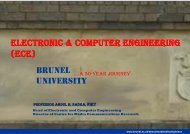D2.3 Interim Report on Pilot Services - the School of Engineering ...
D2.3 Interim Report on Pilot Services - the School of Engineering ...
D2.3 Interim Report on Pilot Services - the School of Engineering ...
You also want an ePaper? Increase the reach of your titles
YUMPU automatically turns print PDFs into web optimized ePapers that Google loves.
preferred <strong>the</strong> bottom and mixed positi<strong>on</strong>s shown <strong>on</strong> Catalan and Spanish channelsrespectively while British viewers chose <strong>on</strong>ly <strong>the</strong> bottom positi<strong>on</strong>.Habits and c<strong>on</strong>venti<strong>on</strong> may also explain why colours were favoured as first choice forspeaker identificati<strong>on</strong> in Spain, whereas <strong>the</strong> results in <strong>the</strong> UK present a different andmore complex landscape. Yet, some interesting implicati<strong>on</strong>s are emerging here. Forinstance, <strong>the</strong> deaf, not <strong>on</strong>ly in <strong>the</strong> UK but also in <strong>the</strong> Spanish tests, seem to likedisplacement and colours, but not tags. In c<strong>on</strong>trast, <strong>the</strong> hard-<strong>of</strong>-hearing clearly prefer tagsand reject displacement. This may be due to <strong>the</strong> age factor. The deaf viewers taking partin <strong>the</strong> tests were aged between 22 and 45 years old and were used to reading colours andchasing informati<strong>on</strong> <strong>on</strong> a screen, whe<strong>the</strong>r <strong>on</strong> TV or <strong>on</strong> a computer screen. The hard-<strong>of</strong>hearingare generally older and less used to doing this. For <strong>the</strong>m, tags pose fewerproblems for speaker identificati<strong>on</strong>. Needless to say, both groups are potentially within<strong>the</strong> subtitling audience, which illustrates <strong>the</strong> difficulty <strong>of</strong> finding a standardised form <strong>of</strong>SDH that can please all <strong>of</strong> its users.Finally, a fur<strong>the</strong>r comment is in order with regard to <strong>the</strong> importance <strong>of</strong> c<strong>on</strong>venti<strong>on</strong>s in <strong>the</strong>tests. In <strong>the</strong> Spanish tests <strong>on</strong> positi<strong>on</strong> and identificati<strong>on</strong>, <strong>the</strong> participants’ views regardingspecific issues do not seem to corresp<strong>on</strong>d to <strong>the</strong>ir views <strong>on</strong> overall preference. In o<strong>the</strong>rwords, whereas <strong>the</strong>y identify a given method as <strong>the</strong> best positi<strong>on</strong> or <strong>the</strong> best way toidentify speakers, <strong>the</strong>y <strong>the</strong>n choose ano<strong>the</strong>r <strong>on</strong>e, usually <strong>the</strong> <strong>on</strong>e applied in <strong>the</strong>ir country,as <strong>the</strong>ir preferred positi<strong>on</strong> or identificati<strong>on</strong> method. It would appear that <strong>the</strong>y objectivelyadmit <strong>the</strong> validity <strong>of</strong> a given method but end up choosing what is c<strong>on</strong>venti<strong>on</strong>al in <strong>the</strong>ircountry. This mismatch has also been found in recent experiments with eye-trackingtechnology (Tuominen, 2008), where <strong>the</strong> viewers’ preferences do not corresp<strong>on</strong>d to whathas been identified as objectively better by <strong>the</strong> eye-tracker. In <strong>the</strong>se cases, and given <strong>the</strong>above-menti<strong>on</strong>ed importance given to empirical research, should broadcasters andservice providers go with <strong>the</strong> eye-tracking evidence and against <strong>the</strong> viewers’ statedpreferences? Would this not be a form <strong>of</strong> enlightened despotism, where all is d<strong>on</strong>e for <strong>the</strong>viewers, but nothing by <strong>the</strong> viewers? Would it be better instead to disregard <strong>the</strong> empiricalevidence and go with <strong>the</strong> viewers’ stated preferences, given that <strong>the</strong>y are <strong>the</strong> c<strong>on</strong>sumers?Although it is still early to answer any <strong>of</strong> <strong>the</strong>se questi<strong>on</strong>s, it seems advisable to look for ahappy medium between c<strong>on</strong>sidering that <strong>the</strong> c<strong>on</strong>sumer is always right and regarding <strong>the</strong>eye-tracker as <strong>the</strong> be-all and end-all <strong>of</strong> <strong>the</strong> research. The approach adopted in <strong>the</strong>DTV4All project is to regard viewers’ preferences and empirical research ascomplementary. The initial steps towards <strong>the</strong> optimisati<strong>on</strong> <strong>of</strong> SDH in digital TV <strong>on</strong> thisbasis have been outlined.In audio descripti<strong>on</strong> fur<strong>the</strong>r analysis, such as that carried out by corpus linguistics, andresulting data ga<strong>the</strong>red through <strong>the</strong> experiment is expected to be studied throughdifferent methodological approaches such as eye-tracking. The outcome will show somepossible universals, or laws, or regularities in <strong>the</strong> recepti<strong>on</strong> <strong>of</strong> visual input. This wouldhave implicati<strong>on</strong>s for <strong>the</strong> formulati<strong>on</strong> <strong>of</strong> harm<strong>on</strong>ised guidelines for AD scriptwritingacross Europe, and <strong>the</strong> possibility <strong>of</strong> <strong>the</strong> translati<strong>on</strong> <strong>of</strong> a source audio-descripti<strong>on</strong> text. Itmay, <strong>on</strong> <strong>the</strong> o<strong>the</strong>r hand, show that while from a top down perspective it was thought that<strong>the</strong>re existed a uniform society and culture, we Europeans are still different and perhapsneed more time before we go in search <strong>of</strong> comm<strong>on</strong> cultural behaviour.Page 30
















